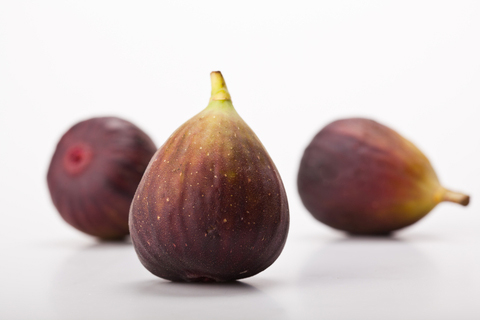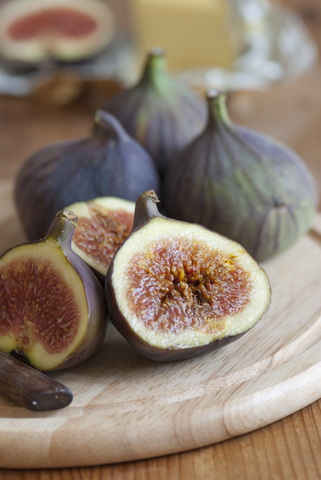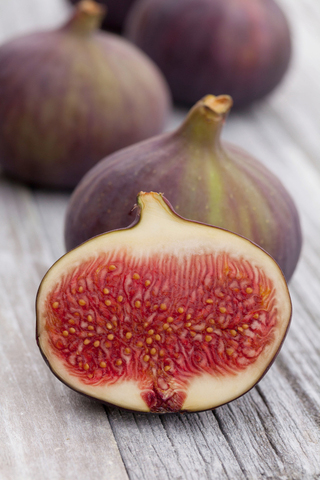cdkitchen > feeddaily blog

National Fig Week
by Guest Writer, Valerie Whitmore
Today kicks off National Fig Week.
Dating back to the Stone Age, hundreds of varieties of figs have emerged. The most commonly found ones here in the US are Smyrna (Calimyrna) and Mission. Fresh figs are usually found in May through November. They are highly perishable and need to be used almost immediately upon purchase. You can store them in the fridge for a couple of days. If you can't find fresh figs many stores carry them canned (usually in a syrup but sometimes in water), dried, and candied

Figs aren't actually a fruit. Rather, they are the flower of the tree - their seeds (called achenes) are actually the fruit of the fig tree.

Fresh figs are a good source of potassium and fiber, and contain 74 calories per 100g.
Dried figs are a good source of potatssium but also are rich in magnesium, iron and copper. They contain 255 calories per 100g.

Figs can be used in place of prunes in recipes Like prunes, however, they can act as a laxative - so watch your consumption!
Despite being made up of over 50% sugar, they are one of those truly versatile ingredients that can be used in both sweet and savory dishes - from appetizers to desserts - and even in cocktails.
If you haven't tried cooking with figs I highly recommend it. They are simple to use and yield delicious results To prepare them, simply wash and trim the stem. You can eat them peeled or unpeeled. Dried figs can be eaten or used in recipes as is, or rehydrated before using.
Here are some recipe ideas to get you started:
 Candied Figs
Candied Figs
Takes three days to make but the process is quite simple and uses only four ingredients.
 Fig Nut Bread
Fig Nut Bread
A rich quick-bread that not only has figs in the bread but also calls for a fig syrup glaze.
 Pork Medallions With Fig and Port Wine Sauce
Pork Medallions With Fig and Port Wine Sauce
The dried figs are stewed in a port wine sauce, perfectly paired with the pork tenderloin.
And if you've tried and tried to find figs in your local stores but have struck out, you can usually substitute apricots for the figs. Dried apricots for dried figs, and ripe apricots for ripe figs - pound per pound. The flavor will be slightly different but the overall results should be similar.
Dating back to the Stone Age, hundreds of varieties of figs have emerged. The most commonly found ones here in the US are Smyrna (Calimyrna) and Mission. Fresh figs are usually found in May through November. They are highly perishable and need to be used almost immediately upon purchase. You can store them in the fridge for a couple of days. If you can't find fresh figs many stores carry them canned (usually in a syrup but sometimes in water), dried, and candied

Figs aren't actually a fruit. Rather, they are the flower of the tree - their seeds (called achenes) are actually the fruit of the fig tree.

Fresh figs are a good source of potassium and fiber, and contain 74 calories per 100g.
Dried figs are a good source of potatssium but also are rich in magnesium, iron and copper. They contain 255 calories per 100g.

Figs can be used in place of prunes in recipes Like prunes, however, they can act as a laxative - so watch your consumption!
Despite being made up of over 50% sugar, they are one of those truly versatile ingredients that can be used in both sweet and savory dishes - from appetizers to desserts - and even in cocktails.
If you haven't tried cooking with figs I highly recommend it. They are simple to use and yield delicious results To prepare them, simply wash and trim the stem. You can eat them peeled or unpeeled. Dried figs can be eaten or used in recipes as is, or rehydrated before using.
Here are some recipe ideas to get you started:
 Candied Figs
Candied Figs
Takes three days to make but the process is quite simple and uses only four ingredients.
 Fig Nut Bread
Fig Nut Bread
A rich quick-bread that not only has figs in the bread but also calls for a fig syrup glaze.
 Pork Medallions With Fig and Port Wine Sauce
Pork Medallions With Fig and Port Wine Sauce
The dried figs are stewed in a port wine sauce, perfectly paired with the pork tenderloin.
And if you've tried and tried to find figs in your local stores but have struck out, you can usually substitute apricots for the figs. Dried apricots for dried figs, and ripe apricots for ripe figs - pound per pound. The flavor will be slightly different but the overall results should be similar.
Recipe Quick Jump
